There are two kinds of changes that happen to metals when they are exposed to elevated temperature, namely instantaneous changes and metallurgical changes.
Instantaneous changes are reversible when the temperature returns to normal, while metallurgical changes, usually involving phase transformation, are permanent. Examples of phase transformations include solution annealing, precipitation hardening, quenching, tempering of steel, melting, etc. Creep and stress relaxation are diffusion-based metallurgical changes that do not involve phase transformations. Most metallurgical changes are functions of time and temperature. Higher temperatures increase the reaction rates, per an Arrhenius relationship.

Figure 1 shows the instantaneous effect of temperature on the tensile properties of Alloy 25 HT (C17200 TH04) copper beryllium. The properties are listed with respect to their room temperature value. The curves are non-linear, indicating that the rate of change increases or decreases with temperature. Note that the yield strength, elastic modulus and tensile strength remain relatively stable around room temperature and gradually start to fall off as the temperature increases. As the temperature difference increases, the rate of change increases as well. The tensile elongation, on the other hand, displays curvature opposite to the strengths and modulus. The rate of change with respect to temperature is largest at room temperature and decreases as the temperature change increases. The curve also has a distinct inflection point, which indicates that at some elevated temperature it passes through a minimum ductility.
Note also that the strength, modulus and elongation increase as the temperature drops below room temperature. Increased strength and increased elongation indicate an increase in toughness at cryogenic temperatures. This is true for most copper alloys and is the opposite of what happens with most steel alloys. While steel alloys become more brittle at low temperatures, copper alloys become tougher. While steel alloys become more ductile at elevated temperature, copper alloys become more brittle.
Figure 2 shows the effect of metallurgical changes on the tensile properties of Alloy 25 HT, with the effect of instantaneous change removed. While Figure 1 only showed changes with respect to temperature, Figure 2 must also include the effects of time, as metallurgical changes are functions of both time and temperature.
Alloy 25 is a precipitation hardening alloy. The precipitation reaction begins around 500°F (260°C). Below this temperature, only instantaneous and diffusion-based property changes occur. Note that in these curves, the changes are nonlinear functions of both time and temperature. The fact that these curves are nearly linear on a logarithmic scale indicates that the changes are exponential functions of time. Note also that at early stages, the rate of change increases as the temperature difference increases, before stabilizing. This stabilization occurs when the precipitation reaction finishes and the material is completely overaged.

Figure 2. Time Dependent Change in Alloy 25 HT Properties with Temperature.
For this testing, the tensile samples were heated to the desired temperature, held there for the indicated time, then allowed to completely cool to room temperature. The actual tensile testing was then conducted at room temperature. This particular testing only measures the effect of metallurgical changes, not instantaneous change.
The two sets of curves here separated the effects of instantaneous and metallurgical changes. In many applications, both changes would be occurring simultaneously, further complicating prediction of performance at elevated temperature, particularly when metallurgical changes are involved. Even at elevated temperatures that are insufficient to create phase changes, stress relaxation can occur. You will need to carefully consider the material to use in any application that needs to function at elevated temperatures for long periods of time. You may need to use finite element analysis simulations that incorporate both time and temperature effects.
You should also try to avoid using materials at temperatures where such metallurgical changes can happen. However, you do not have to do this work on your own. Your material supplier will let you know the maximum permissible exposure temperature for the materials that they produce.
Thanks for joining us for another edition of In Our Element. For ongoing industry updates, connect with us on LinkedIn.